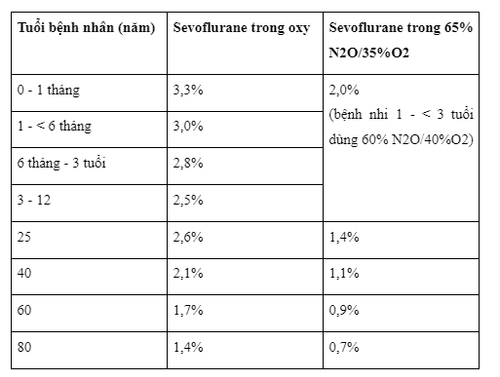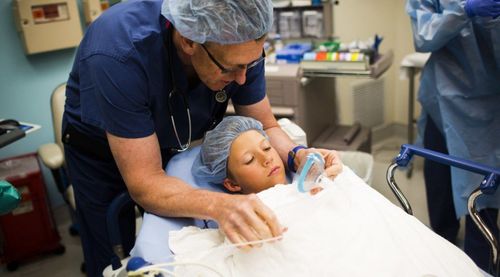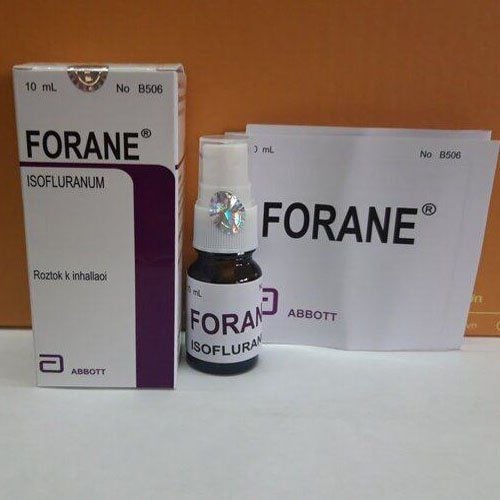This is an automatically translated article.
Sevoflurane is a liquid medicine for inhalation, the main ingredient is Sevoflurane. The drug is used in anesthesia, anesthesia during surgery.1. What is Sevorane?
1 vial of Sevorane 250ml with the main ingredient is Sevoflurane with 100% content, made in the form of a liquid bottle for inhalation. Sevoflurane is a colorless, volatile liquid. When entering the body through the respiratory tract, the concentration of this active ingredient will increase rapidly in the blood due to its low blood solubility. With this feature, when using the drug, the induction of anesthesia will take place very quickly, the recovery time is also very fast. Therefore, the drug is often indicated for use in minor surgery.
2. What does Sevorane do?
Mechanism of action of Sevoflurane:
Cardiovascular effects: Sevoflurane reduces cardiovascular function, dose-dependently, without reducing mean arterial pressure. This drug does not cause an increase in heart rate at doses less than 2 times the minimum alveolar concentrations; Nervous system effects: Sevoflurane has a minimal effect on CO2 response in subjects with normal intracranial pressure. The drug has the ability to reduce the rate of oxygen exchange of the brain. Indications for use of Sevorane:
Used in induction and maintenance of anesthesia during surgery in inpatients and outpatients, both adults and children. Contraindications to the use of Sevorane:
Patients with hypersensitivity to sevoflurane or other inhalation anesthetics containing halogens (eg, history of fever, liver dysfunction or leukocytosis of unknown cause). during anesthesia with these drugs); Persons genetically susceptible to malignant hyperthermia syndrome; The patient has a contraindication to general anesthesia.
2. Usage and dosage of Sevorane
How to use: Sevorane is used by inhalation into the body through the respiratory tract. Note, when using the drug, it is necessary to use a specialized volumetric sprayer for the purpose of accurately quantifying the concentration of the drug put into the body.
Dosage: Pre-anesthesia is selected depending on the state of each patient and at the discretion of the doctor. Usually anticholinergics are used. The recommended dosage for each case is as follows:
Surgical anesthesia: It is recommended to use a vaporizer specially calibrated for Sevoflurane to check the exact concentration of the drug delivered. The MAC (minimum alveolar concentration) value of sevoflurane decreases with age and decreases with addition of N2O. The following table shows the mean MAC values for different age groups:

Induction of anesthesia: Dosage depends on the patient and titrated to achieve the desired effect depending on age and clinical condition. Next, inhaled sevoflurane can be administered intravenously with a short-acting barbiturate or another intravenous anesthetic. Sevoflurane induction of anesthesia can be achieved either in oxygen or in an Oxygen-N2O mixture. Adults who inhale sevoflurane concentrations up to 5% will achieve operable anesthesia in less than 2 minutes. Children who inhale sevoflurane concentrations up to 7% will achieve surgical anesthesia in less than 2 minutes. If for induction of anesthesia in patients who are not pre-anesthetic, sevoflurane can be inhaled to a concentration of 8%; Maintenance of anesthesia: Anesthesia for surgery is maintained with sevoflurane concentration at 0.5 - 3%, with/without N2O; Recovery: After anesthesia with sevoflurane, the time to wake up is usually short. Therefore, patients can get pain relief measures soon after surgery; Elderly: MAC will decrease with increasing age. The mean concentration of sevoflurane to achieve MAC in 80-year-old patients would be about 50% of the concentration required for 20-year-old patients; Children: Follow the table of MAC values above. Overdose: If an overdose of Sevorane is used, it should be stopped immediately. Then, ensure airway clearance, assisted ventilation, or controlled ventilation with pure oxygen, maintain appropriate cardiovascular function for the patient.
3. Sevorane side effects
Like other potent inhalation anesthetics, Sevorane may cause dose-dependent cardiorespiratory depression. Most of the side effects of the drug are mild or moderate, lasting for a short time. In the case of nausea, vomiting, and delirium in the postoperative period, the general sequelae of surgery and general anesthesia may occur as a result of inhalation anesthesia, other drugs administered during and after surgery, or response to patient response during surgery.
Some side effects of Sevorane are:
Immune system: Anaphylactoid reactions, hypersensitivity; Blood and lymphatic system: Decrease/ increase in white blood cells; Psychiatric: Excitement, confusion, confusion; Nervous system: Drowsiness, dizziness, convulsions, headache, dystonia; Cardiovascular: bradycardia/tachycardia, atrial fibrillation, complete atrioventricular block, arrhythmia, extrasystoles, ventricular extrasystoles, supraventricular extrasystoles, cardiac arrest, prolongation of the QT interval with torsades de pointes; Vascular system: Hypotension/hypertension; Respiratory, thoracic and mediastinal: Cough, respiratory disorders, laryngospasm, apnea, hypoxia, bronchospasm, asthma, dyspnea, wheezing, pulmonary edema; Gastrointestinal: Nausea, vomiting, increased salivation; Renal and urinary: urinary retention, glucoseuria, acute renal failure; Hepatobiliary: Hepatitis, liver failure, liver necrosis; Skin and subcutaneous tissue: Contact dermatitis, skin itching, skin rash, urticaria, facial edema; Muscle - bone - connective tissue: Muscle spasticity; Whole body or at the injection site: Fever, chills, chest tightness, hypothermia, malignant hyperthermia; Laboratory tests: Abnormal blood sugar levels, elevated AST liver enzymes, abnormal liver function tests, elevated blood creatinine, increased fluoride levels, increased LDH enzyme in the blood, abnormal white blood cell count; Injuries, poisoning, complications: Lower body temperature.
4. Be careful when taking Sevorane
Some notes to remember before and while taking Sevorane:
Sevoflurane can cause respiratory depression. This condition may be aggravated by premedication or other respiratory depression agents. Respiratory control and support should be provided if necessary; Only trained medical personnel should use Sevoflurane for general anesthesia. Facilities should be available to maintain airway, provide artificial respiration, provide oxygen and restore circulation; It is important to know the concentration of Sevoflurane supplied from the evaporator. Because inhalation anesthetics differ in their physical properties, only vaporizers specifically designed for sevoflurane should be used. Anesthesia method should be individualized based on individual patient response; The risk of hypotension and respiratory depression increases with deep anesthesia; In some susceptible patients, potent inhaled anesthetics, including sevoflurane, may increase skeletal muscle metabolism, leading to increased oxygen demand and the clinical syndrome of malignant hyperthermia. The clinical syndrome manifests as hypercapnia, which may include muscle spasticity, tachypnea, tachycardia, cyanosis of the skin, arrhythmias, and unstable blood pressure. Some nonspecific manifestations may also appear during anesthesia such as hypoxia in tissues, abnormal hypercapnia, decreased blood flow. Treatment of malignant hyperthermia is removal of the reactant (eg, sevoflurane), intravenous administration of sodium dantrolene, and supportive care. Treatment includes normalization of the patient's body temperature, respiratory and circulatory support, and management of abnormal acid-base balance disorders using electrolyte solutions. The risk of renal failure may occur more slowly, the patient's urine flow should be monitored and maintained; Use of inhaled anesthetics has been associated with some cases of hyperkalemia, leading to cardiac arrhythmias and death in pediatric patients in the postoperative period. People with neuromuscular disease, especially Duchenne muscular dystrophy, are more susceptible to hyperkalemia. Patients should receive early and aggressive interventional therapy for hyperkalemia and antiarrhythmics, followed by evaluation for underlying neuromuscular disease; There have been cases of prolongation of the QT interval, associated with torsades de pointes. Sevoflurane should be used with caution in patients who are sensitive to the drug; There have been cases of ventricular arrhythmias with the use of Sevorane in pediatric patients with Pompe disease; Extreme caution should be exercised when systemic sevoflurane is used in patients with mitochondrial disorders; There are cases of mild, moderate and severe liver dysfunction, hepatitis after surgery (with/without jaundice). Clinical evaluation is recommended when using sevoflurane in patients with liver problems or on treatment with drugs that may cause liver dysfunction. There have been cases where prior exposure to halogenated hydrocarbon anesthetics, including sevoflurane, with short intervals between administrations may increase the risk of liver damage; During maintenance of anesthesia, up-regulation of sevoflurane concentrations results in a decrease in blood pressure (dose dependent). Excessive hypotension may be related to the depth of anesthesia. In this case, blood pressure can be raised by reducing the concentration of inhaled sevoflurane. Special care should be taken when selecting doses for patients with hypovolaemia, hypotension or performing hemodynamic regulation of the patient based on co-administration with other drugs; Maintain hemodynamic stability while using sevoflurane to avoid the risk of myocardial infarction in patients with coronary artery disease; Recovery from general anesthesia should be carefully assessed before transferring the patient from the recovery room. Anesthesia with Sevoflurane has a rapid recovery rate, so supportive measures to relieve pain after surgery may be needed; Although patients usually wake up within a few minutes of anesthesia with sevoflurane, there have been no detailed studies on the effect of the drug on mental performance after 2-3 days after anesthesia. As with other anesthetics, minor changes in the patient's temperament may persist for several days after anesthesia; The safety of Sevorane in patients with renal failure has not been established, so caution should be exercised when using the drug in this group of subjects; In patients at risk of increased ICP, caution should be exercised when sevoflurane is used in combination with mechanical measures to reduce ICP (eg, hyperventilation); Very few cases of epilepsy have been associated with the use of sevoflurane. The use of the drug has been associated with the occurrence of seizures in children, adolescents, and the elderly. Prior to administering sevoflurane to patients at risk of convulsions, clinical evaluation is required. Deep anesthesia should be limited in children. EEG can help optimize the dose of sevoflurane, avoiding increased seizures in patients with a predisposition to seizures; There have been cases of dystonia with the use of sevoflurane in children; Sevoflurane should be used with caution in obstetric anesthesia during pregnancy because of its ability to relax the uterine muscles, increasing the risk of uterine bleeding; It is not known whether sevoflurane and its metabolites are excreted in human milk. Therefore, mothers should avoid breast-feeding for 48 hours after taking sevoflurane, should eliminate the amount of milk secreted during this time; Patients after general anesthesia should avoid performing tasks that require alertness such as operating machinery, driving, ... until they can do these things safely.
5. Sevorane drug interactions
Some of the drug interactions of Sevorane include:
Caution should be taken when using Sevorane with beta sympathomimetic drugs such as isoprenaline, alpha and beta sympathomimetic drugs such as Adrenalin and Noradrenalin because of possible can cause ventricular tachycardia; Concomitant use of Sevorane with nonselective MAO inhibitors may increase the risk of perioperative exacerbations. These drugs should be discontinued 2 weeks before surgery; Sevorane may reduce blood pressure in patients receiving calcium channel blockers, especially dihydropyridine derivatives; Caution should be exercised when calcium blockers are used concurrently with respiratory anaesthetics such as Sevorane because these drugs have an adverse effect on myocardial contractility; Concomitant use of Sevorane with succinylcholine increases serum potassium levels, leading to cardiac arrhythmias and death in pediatric patients in the postoperative period; Sevorane is safe and effective when used concurrently with drugs commonly used in surgery such as: drugs acting on the autonomic nervous system, drugs acting on the central nervous system, skeletal muscle relaxants, antibiotics. including Aminoglycosides), blood products, hormones and synthetic substitutes, cardiovascular drugs (including epinephrine); Concomitant use of sevoflurane with epinephrine/adrenaline may sensitize the myocardium to the arrhythmogenic effects of exogenous adrenaline; Concomitant use of Sevoflurane with indirect sympathomimetic agents such as Amphetamine, Ephedrine may cause an acute increase in blood pressure; Sevoflurane may enhance the autonomic, inotropic, and psychotropic effects of beta-blockers (through inhibition of the compensatory myocardial mechanism); Concomitant use of sevoflurane with verapamil reduces atrioventricular conduction; Sevoflurane is compatible with barbiturates, can be used in surgery; Benzodiazepines and Opioids may decrease sevoflurane MAC concentrations by a mechanism similar to that of other inhaled anesthetics. Sevoflurane is compatible with Benzodiazepines and Opioids, so it can be used in surgery. Opioids such as Alfetanil and Sufetail when used concurrently with sevoflurane can reduce heart rate, breathing rate and blood pressure; Drugs and substances that increase the activity of the cytochrome P450 isoenzyme CYP2E1 such as isoniazid and alcohol may increase the metabolism of sevoflurane, leading to a significant increase in plasma fluoride concentrations. Concomitant use of Sevoflurane with Isoniazid may increase the hepatotoxicity of IIsoniazid; In patients on long-term use of St John's Wort, there was a case of severe hypotension and prolonged coma after anesthesia with inhaled halogenated anesthetics; Sevoflurane's MAC decreased when used in combination with NO2. MAC values decrease about 50% in adults, about 25% in pediatric patients; Sevoflurane affects the intensity and duration of neuromuscular blockade of non-depolarizing muscle softeners. When used in addition to the anesthetic alfentanil-N2O, sevoflurane increases the potential for neuromuscular blockade of drugs such as Pancuronium, Vecuronium or Atracurium. Dosage adjustment of muscle relaxants is required when co-administered with sevoflurane (similar to isofluran). When assigned to use Sevorane, patients should absolutely coordinate with the instructions of the anesthesiologist and surgeon to ensure the best therapeutic effect and limit unpredictable complications.













